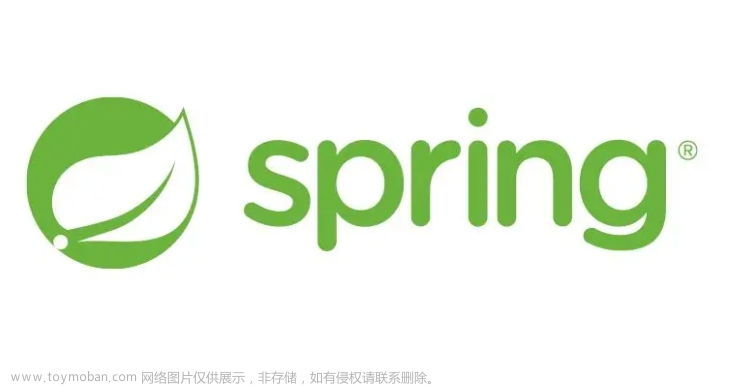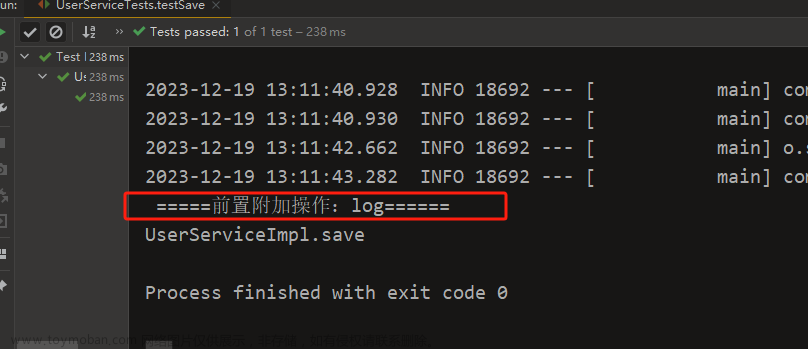1.@Aspect注解
(1) @Aspect注解用于声明一个切面类,我们可在该类中来自定义切面,早在Spring之前,AspectJ框架中就已经存在了这么一个注解,而Spring为了提供统一的注解风格,因此采用了和AspectJ框架相同的注解方式,这便是@Aspect注解的由来,换句话说,在Spring想做AOP框架之前,AspectJ AOP框架就已经很火了,而直接把AspectJ搬过来又不现实,因此,Spring想了一个折中的方案,即只使用AspectJ框架的声明,写法和定义方式(比如@Aspect注解),而底层由Spring自己实现,这样,就避免了我们程序员从AspectJ AOP切换到Spring AOP后,还要再去学一套新的写法了,也正因为如此,如果想要使用Spring AOP,就必须依赖aspectjweaver.jar包(不然谁来提供写法和定义方式),我们可以通过maven进行导入,如下
<!-- 添加对AspectJ框架的依赖 -->
<dependency>
<groupId>org.aspectj</groupId>
<artifactId>aspectjrt</artifactId>
<version>1.9.5</version>
</dependency>
<!-- 除了上面的方式外,也可以直接使用spring-aspects依赖,它里面包含了对AspectJ的依赖 -->
<dependency>
<groupId>org.springframework</groupId>
<artifactId>spring-aspects</artifactId>
<version>${spring.framework.version}</version>
</dependency>
(2) 同时还需使用@EnableAspectJAutoProxy注解来开启Spring对于AspectJ注解的支持,如下
@Configuration
@EnableAspectJAutoProxy
public class Config {
}
如果是基于xml的配置,可通过如下标签进行开启
<aop:aspectj-autoproxy/>
2.自定义一个切面类
(1) 在基于注解的配置下,除了使用@Aspect注解外,还需要声明该切面是一个bean,否则,spring在扫描过程中是会忽略掉这个类的,如下
@Aspect
@Component
public class Logger {
}
(2) 对上面的例子,基于xml配置的写法如下
@Aspect
public class Logger {
}
<!-- xml配置文件中 -->
<beans ...>
<!-- 无论何种配置方式,不要忘了将切面类注册为spring的一个bean -->
<bean id="logger" class="cn.example.spring.boke.Logger"></bean>
</beans>
(3) 由@Aspect注解标注的类,称之为切面类,与普通的类一样,都有成员方法与成员变量,不同的是,切面类还可以包含连接点,通知,引介等与AOP有关的东西
(4) 切面不能再被增强,如果想拿一个切面来增强另一个切面,是不可能的,Spring会将切面类从自动代理(auto-proxying)中排除
3.自定义一个切入点
(1) Spring AOP中的切入点目前只可能是bean中的方法,而对于一个普通类中的方法,是不可能成为切入点的,在Spring中,声明一个切入点主要包括两个部分:一个切入点签名以及一个切入点表达式,如下
//如下定义了一个叫做anyExampleAMethod的切入点,这个切入点会匹配cn.example.spring.boke包下的ExampleA类中的任何方法
//其中,(1)就代表的是切入点表达式,(2)就代表的是切入点签名,注意,这个签名的返回值必须是void
@Pointcut("execution(* cn.example.spring.boke.ExampleA.*(..))") //(1)
public void anyExampleAMethod() {} //(2)
(2) Spring AOP的切入点表达式中,支持如下等切入点标识符
-
execution:最为常用,用于匹配某个包,某个类中的方法
-
within:进行类型匹配,用于匹配某个包下所有类的所有方法或某个指定类中的所有方法,如下
//指定了within的类型,这个切入点会匹配cn.example.spring.boke包下ExampleA类中的任何方法
@Pointcut("within(cn.example.spring.boke.ExampleA)")
public void withinDesignator(){}
- this:进行类型匹配,用于匹配生成的代理对象的类型是否为指定类型,如下
//此前我们提到过,Spring AOP中的底层实现分为jdk动态代理和cglib动态代理,jdk动态代理基于接口,要求目标对象必须实现某个接口,而cglib动态代理基于继承,因此不同的实现方式下,导致Spring生成的代理对象的类型可能不同,这就是this标识符的基础
//首先定义一个接口
public interface Parent {
void register();
void sendEmail();
}
//让我们的ExampleA类,实现这个接口
@Component
public class ExampleA implements Parent{
public void register() {
}
public void sendEmail() {
}
}
//设置@EnableAspectJAutoProxy注解中的proxyTargetClass属性值为false,表示使用jdk动态代理,为true,表示使用cglib动态代理,默认值为false,不过我们这里显式的声明出来
@Configuration
@EnableAspectJAutoProxy(proxyTargetClass = false)
@ComponentScan(basePackages = "cn.example.spring.boke")
public class Config {
}
//切面类,在其中声明一个this标识符,并指定类型为ExampleA
@Aspect
@Component
public class Logger {
/**
* this标识符,进行类型匹配,用于匹配代理对象的类型是否为指定类型
*/
@Pointcut(value = "this(cn.example.spring.boke.ExampleA)")
public void thisDesignator(){}
@Around(value = "thisDesignator()")
public void around(ProceedingJoinPoint joinPoint) throws Throwable {
System.out.println(new Date() + " 开始执行...");
joinPoint.proceed();
System.out.println(new Date() + " 结束执行...");
}
}
//执行如下打印方法,可见通知未被执行,原因就是因为我们使用了jdk动态代理,Spring为我们生成的代理对象继承自jdk中的Proxy类并实现了Parent接口,它不属于ExampleA类型,自然而然切入点匹配失败,我们的通知未被执行
AnnotationConfigApplicationContext ctx = new AnnotationConfigApplicationContext(Config.class);
ctx.getBean(Parent.class).register();
ctx.getBean(Parent.class).sendEmail();
//打印一下系统中代理对象的类型是否为ExampleA,结果为false
System.out.println(ctx.getBean(Parent.class) instanceof ExampleA);
//为了能进行匹配,我们可以将@EnableAspectJAutoProxy中的proxyTargetClass属性设置为true,使用cglib动态代理,这时再执行上面的打印方法,通知就会被执行了,原因就是因为使用了cglib动态代理后,Spring为我们生成的代理对象是继承自ExampleA,当然属于ExampleA类型,因此通知会被执行
@EnableAspectJAutoProxy(proxyTargetClass = true)
-
target:进行类型匹配,用于匹配目标对象的类型是否为指定类型,跟上面的this类似
-
args:进行方法参数匹配,用于匹配方法的参数类型是否为指定类型,如下
//ExampleA中的register方法的参数为String
@Component
public class ExampleA{
public void register(String name) {
}
public void sendEmail() {
}
}
@Aspect
@Component
public class Logger {
/**
* 指定了args参数的类型为String,因此只会与ExampleA中的register方法匹配
*/
@Pointcut(value = "args(java.lang.String)")
public void argsDesignator() {}
@Around(value = "argsDesignator()")
public void around(ProceedingJoinPoint joinPoint) throws Throwable {
System.out.println(new Date() + " 开始执行...");
joinPoint.proceed();
System.out.println(new Date() + " 结束执行...");
}
}
-
@target:用于匹配目标对象的类上有没有标注指定注解
-
@args:用于匹配方法的参数的所属类上有没有标注指定注解
-
@within:用于匹配某个类上有没有标注指定注解
-
@annotation:最常用,用于匹配某个方法上有没有标注指定注解
(3) Spring的AOP是基于代理实现的,因此,在目标对象中进行内部调用是不会被拦截的(即this指针会导致AOP失效问题),此外,对于jdk动态代理,只能拦截public方法,而对于cglib动态代理,会拦截public和protected方法(package-visible 方法在配置后也能被拦截)
(4) Spring AOP还提供了一个PCD bean,用于按照bean的名称进行切入,它是Spring AOP独有的,如下
//匹配所有beanName以A结尾的bean
@Pointcut("bean(*A)")
public void pcd() {}
4.组合切入点表达式
(1) 可以通过 &&,|| 和 !来组合切入点表达式,如下
//切入所有public方法
@Pointcut("execution(public * *(..))")
public void allPublicMethod() {}
//切入boke包下所有类中的所有方法
@Pointcut("within(cn.example.spring.boke.*)")
public void methodInBokePackage() {}
//使用 && 操作符,将上面两个切入点表达式组合起来,即切入boke包下所有类中的所有public方法
@Pointcut("allPublicMethod() && methodInBokePackage()")
public void allPublicMethodInBokePackage() {}
5.常见切入点表达式例子
(1)在实际工作中,我们的切入点表达式的通常形式为:execution(modifiers-pattern? ret-type-pattern declaring-type-pattern?name-pattern(param-pattern) throws-pattern?),其中ret-type-pattern表示一个方法的返回类型, 用 * 号可以代表任何类型; name-pattern表示方法名称,用 * 可以进行全部或部分名称匹配; param-pattern表示方法参数,其中用()代表无参方法,用(..)代表任何数量的参数(0个或多个),用()代表1个参数,(, String)代表有两个参数,第一个参数可以是任何类型,而第二个参数只能是String类型; 除此之外,其他带有 ? 的都是选填项,可不填写
(2)常见例子
//匹配任意public方法
execution(public * *(..))
//匹配任意名称以set开头的方法
execution(* set*(..))
//匹配com.xyz.service包下,AccountService类下的任意方法
execution(* com.xyz.service.AccountService.*(..))
//匹配com.xyz.service包下,任意类下的任意方法
execution(* com.xyz.service.*.*(..))
//匹配com.xyz.service包及其子包下,任意类下的任意方法
execution(* com.xyz.service..*.*(..))
//匹配com.xyz.service包下,任意类下的任意方法
within(com.xyz.service.*)
//匹配com.xyz.service包及其子包下,任意类下的任意方法
within(com.xyz.service..*)
//匹配代理对象的类型为AccountService的类下的任意方法
this(com.xyz.service.AccountService)
//匹配目标对象的类型为AccountService的类下的任意方法
target(com.xyz.service.AccountService)
//匹配方法参数只有一个且参数类型为Serializable的方法,注意它与execution(* *(java.io.Serializable))的一点区别:execution这个例子只能匹配参数类型为Serializable的方法,如果说某个方法的参数类型是Serializable的子类,是不会匹配的,而下面args这个例子可以匹配参数类型为Serializable或其子类的方法
args(java.io.Serializable)
//匹配标注了@Transactional注解的目标对象中的任意方法
@target(org.springframework.transaction.annotation.Transactional)
//匹配标注了@Transactional注解的类中的任意方法
@within(org.springframework.transaction.annotation.Transactional)
//匹配标注了@Transactional注解的任意方法
@annotation(org.springframework.transaction.annotation.Transactional)
//匹配方法的参数有且只有一个且该参数的所属类上标注了@Classified注解的任意方法
@args(com.xyz.security.Classified)
//匹配beanName为tradeService的bean中的任意方法
bean(tradeService)
//匹配所有以Service作为beanName结尾的bean中的任意方法
bean(*Service)
6.编写良好的pointcuts
(1)Spring将切入点标识符分为3大类,分别为:
- Kinded:类型标识符,如execution, get, set, call等,它们都是根据类型进行选择,比如execution选择的都是可执行方法这一类型,其中除了execution,其他的都是AspectJ框架提供的
- Scoping:范围标识符,如within;
- Contextual:上下文标识符,如this, target和@annotation,它们都是根据方法所处的环境(比如在哪个类中)进行选择
Spring建议一个良好的切入点表达式应该至少包括前两种类型(kinded和scoping,在这两种标识符中scoping又特别重要,因为它的匹配速度非常快,可以快速的排除掉那些不应该被处理的方法),此外在有根据上下文环境的需求时,可以包括contextual标识符
7.声明一个通知
(1)在前面已经提及过通知,它是增强的逻辑,与切入点相关联,会在切入点执行前或执行后执行,在Spring中总共分为5大类,如下
- Before Advice:使用@Before注解可定义前置通知,它会在切入点执行之前执行
@Aspect
@Component
public class Logger {
@Before(value = "execution(* cn.example.spring.boke.ExampleA.*(..))")
public void before() {
//...
}
}
- After Returning Advice:使用@AfterReturning注解可定义返回通知,它会在切入点"正常"执行之后执行
//一个普通的bean ExampleA
@Component
public class ExampleA{
public String doSomething() {
return "finish";
}
}
//有时候,我们可能需要访问切入点执行后的返回值,那么我们可以使用@AfterReturning注解中的returning属性来指定返回值的名称,然后再给这个切面方法添加一个形参,这个形参类型即为切入点执行后的返回值类型(或其父类型,但不能完全不一致,否则切面会切入失败),形参名要与刚刚设置过的returning属性值一致,如下例
@Aspect
@Component
public class Logger {
@AfterReturning(value = "execution(* cn.example.spring.boke.ExampleA.*(..))", returning = "returnVal")
public void afterReturning(Object returnVal) {
System.out.println(new Date() + " 开始执行...");
System.out.println(returnVal);
System.out.println(new Date() + " 结束执行...");
}
}
- After Throwing Advice:使用@AfterThrowing注解可定义异常通知,它会在切入点触发异常之后执行
//同样,我们有时候也期望访问切入点执行过程中抛出的异常,与返回通知一致,例子如下
@Aspect
@Component
public class Logger {
@AfterThrowing(value = "execution(* cn.example.spring.boke.ExampleA.*(..))", throwing = "throwable")
public void afterReturning(Throwable throwable) {
System.out.println(new Date() + " 开始执行...");
System.out.println(throwable);
System.out.println(new Date() + " 结束执行...");
}
}
- After (Finally) Advice:使用@After注解可定义后置通知,它会在切入点无论以何种方式执行(正常或异常)后执行,常用于释放资源等目的,类似于try-catch语句中的finally块,它与@AfterReturning的区别是,@AfterReturning只适用于切入点正常返回
@Aspect
@Component
public class Logger {
@After(value = "execution(* cn.example.spring.boke.ExampleA.*(..))")
public void afterReturning() {
//...
}
}
- Around advice:使用@After注解可定义环绕通知,它既可以在切入点之前执行通知,又可以在切入点之后执行,甚至可以不用执行切入点,是最为灵活强大的通知
@Aspect
@Component
public class Logger {
//环绕通知方法可不声明形参,但如果要声明形参,第一个形参的类型必须是ProceedingJoinPoint类型,对ProceedingJoinPoint调用proceed方法后会导致切入点真正的执行,此外,proceed方法还有一个重载方法,我们可以对它传递一个Object[],那么当切入点执行时会以这个数组中的值作为方法参数值来执行
//我们可以调用一次,多次或根本不调用proceed方法
@Around(value = "execution(* cn.example.spring.boke.ExampleA.*(..))")
public void afterReturning(ProceedingJoinPoint joinPoint) {
Object returnVal = null;
try {
//...
returnVal = joinPoint.proceed();
//...
} catch (Throwable e) {
//...
e.printStackTrace();
}
return returnVal;
}
}
8.切入点信息获取
(1)有时候,我们期望获取到切入点相关信息,比如它的签名,形参等信息,Spring为我们提供了JoinPoint类型,用于获取相关信息,在前面的环绕通知的例子中,我们就已经使用了JoinPoint的子类型ProceedingJoinPoint,它添加了proceed方法,来显式的调用执行切入点
@Aspect
@Component
public class Logger {
//除了下面的例子外,使用JoinPoint,还可以获取到切入点的其他一些信息,可参考api文档
@Before(value = "execution(* cn.example.spring.boke.ExampleA.*(..))")
public void before(JoinPoint joinPoint) {
System.out.println("被拦截的类:" + joinPoint.getTarget().getClass().getName());
System.out.println("被拦截的方法:" + ((MethodSignature) joinPoint.getSignature()).getMethod().getName());
System.out.println("被拦截的方法参数:" + Arrays.toString(joinPoint.getArgs()));
}
}
9.通知执行顺序
(1)不同切面类中的通知,在默认情况下,按照所在切面类名的字典序排序,若其排序越高则优先级也就越高,如下
@Configuration
@EnableAspectJAutoProxy
@ComponentScan(basePackages = "cn.example.spring.boke")
public class Config { }
@Component
public class ExampleA{
public void doSomething() {
System.out.println("doSomething...");
}
}
//声明两个切面类TimerLogger和OperationLogger
@Aspect
@Component
public class TimerLogger {
@Before(value = "execution(* cn.example.spring.boke.ExampleA.*(..))")
public void a() {
System.out.println("timer...");
}
}
@Aspect
@Component
public class OperationLogger {
@Before(value = "execution(* cn.example.spring.boke.ExampleA.*(..))")
public void a() {
System.out.println("operation...");
}
}
//启动容器,观察打印结果
AnnotationConfigApplicationContext ctx = new AnnotationConfigApplicationContext(Config.class);
ctx.getBean(ExampleA.class).doSomething();
//打印结果如下,OperationLogger中的前置通知先执行,TimerLogger中的前置通知后执行,就是因为O的字典序列大于T,因此OperationLogger中的通知的优先级高于TimerLogger中的,而对于前置通知而言,优先级越高的越先执行,对于后置通知,优先级越高的越后执行
operation...
timer...
doSomething...
//我们可以将TimerLogger改为ATimerLogger,这样的话它里面的前置通知就会先执行了
@Aspect
@Component
public class ATimerLogger {
@Before(value = "execution(* cn.example.spring.boke.ExampleA.*(..))")
public void a() {
System.out.println("timer...");
}
}
(2)我们可以对切面类实现Ordered接口或添加@Order注解来显示的指定优先级,其中指定的值越小,优先级越高
//此时TimerLogger的优先级高于OperationLogger
@Aspect
@Component
@Order(1)
public class TimerLogger {
@Before(value = "execution(* cn.example.spring.boke.ExampleA.*(..))")
public void a() {
System.out.println("timer...");
}
}
@Aspect
@Component
@Order(2)
public class OperationLogger {
@Before(value = "execution(* cn.example.spring.boke.ExampleA.*(..))")
public void a() {
System.out.println("operation...");
}
}
(3)对于同个切面类中的相同类型的通知,其优先级只与通知方法名字典序的排序有关,排序越高,优先级越高,如下
//Logger切面类中定义了两个前置通知为aPrint和bPrint
@Aspect
@Component
public class Logger {
@Before(value = "execution(* cn.example.spring.boke.ExampleA.*(..))")
public void aPrint() {
System.out.println("a");
}
@Before(value = "execution(* cn.example.spring.boke.ExampleA.*(..))")
public void bPrint() {
System.out.println("b");
}
}
//启动容器,可见aPrint先于bPrint,这就是因为a的字典序高于b
a
b
doSomething...
//将aPrint改为caPrint,这时bPrint会先执行,因为此时它的字典序高
@Before(value = "execution(* cn.example.spring.boke.ExampleA.*(..))")
publicvoid caPrint() {
System.out.println("a");
}
//此外使用@Order注解,无法改变优先级,因为此时显式指定优先级的策略已经失效了,如下面这个例子还是按照之前默认的优先级进行执行
@Aspect
@Component
public class Logger {
@Before(value = "execution(* cn.example.spring.boke.ExampleA.*(..))")
@Order(Ordered.LOWEST_PRECEDENCE)
public void aPrint() {
System.out.println("a");
}
@Before(value = "execution(* cn.example.spring.boke.ExampleA.*(..))")
@Order(Ordered.HIGHEST_PRECEDENCE)
public void bPrint() {
System.out.println("b");
}
}
10.Introductions(引介)文章来源:https://www.toymoban.com/news/detail-416254.html
(1)引介能够使指定的对象实现某些接口,并提供对这些接口的实现,以达到向对象中动态添加它所没有方法的目的,例子如下文章来源地址https://www.toymoban.com/news/detail-416254.html
//我们希望向ExampleA类中增加某些新的方法
@Component
public class ExampleA{ }
//声明一个接口,这个接口里的方法即为我们希望增加的新的方法
public interface Extention {
void doSomething();
}
//新方法的具体实现
public class ExtentionImpl implements Extention{
@Override
public void doSomething() {
System.out.println("doSomething...");
}
}
//定义一个切面
@Component
@Aspect
public class MyAspect {
//使用@DeclarePrents注解,声明被拦截的类有一个新的父类型,其中value指定拦截哪些类,在下面这个例子中指定拦截cn.example.spring.boke包下的所有类,同时指定它们的父类型均为Extention,具体的实现为ExtentionImpl
@DeclareParents(value = "cn.example.spring.boke.*", defaultImpl = ExtentionImpl.class)
public Extention extention;
}
//开启AOP
@Configuration
@EnableAspectJAutoProxy
@ComponentScan(basePackages = "cn.example.spring.boke")
public class Config { }
//启动容器,从容器中获取到exampleA并将其强制转换为Extention,这样我们就能使用向ExampleA中新添加的方法了
AnnotationConfigApplicationContext ctx = new AnnotationConfigApplicationContext(Config.class);
Extention exampleA = (Extention)ctx.getBean("exampleA");
exampleA.doSomething();
到了这里,关于Spring AOP官方文档学习笔记(二)之基于注解的Spring AOP的文章就介绍完了。如果您还想了解更多内容,请在右上角搜索TOY模板网以前的文章或继续浏览下面的相关文章,希望大家以后多多支持TOY模板网!












